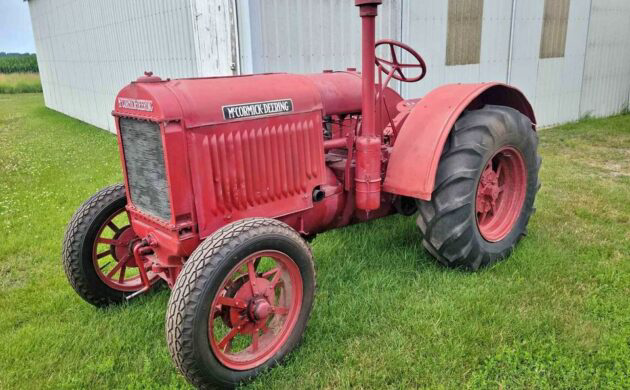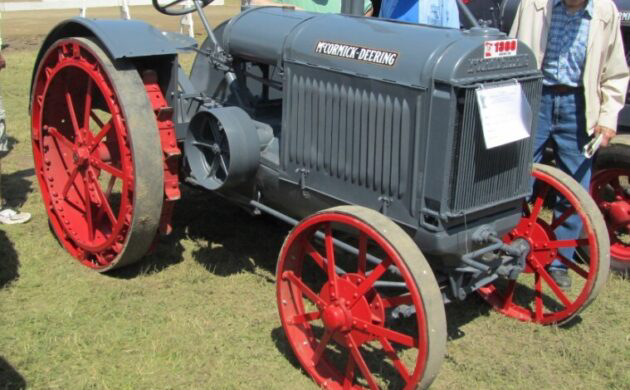Just days off the Long Island Antique Power Association July show (really excellent!), I’m ready to wax poetic about this McCormick-Deering 10-20 tractor, here on facebook Marketplace. But first, let’s seek some context. McCormick-Deering was never a company – it was a brand under International Harvester, the parent company created when John Pierpont Morgan brokered a deal to combine McCormick, Deering, and several other farm machinery makers in 1902. The resulting company owned the lion’s share of the industry and eventually sold its products all over the world. Its stalwart competitor, Henry Ford’s Fordson, drove innovation, though, and marginalized IH’s products in those early years. The Fordson tractor’s strong chassis, integrated components, and cheap price meant that IH had to do something- fast. In 1923, it redesigned its 15-30, substantially improving it as well as reducing its price. It also rebranded this tractor under the McCormick-Deering name. The 10-20 received the same treatment. It was the baby sister to the big 15-30, with just 22 hp versus 33. Our featured tractor is priced at just $1000, it runs, and you can drive it home from Paynesville, Minnesota, à la the movie The Straight Story. We have NW Iowa to thank for this inspiring tip!
The new tractors sold very well; production figures imply that the 10-20 was one of the best-selling IH tractors ever. Their bathtub construction protected mechanical components but made it simple to unbolt panels for repairs. The 10-30 ran International Harvester’s 283.7 cu. in. four-cylinder air-cooled kerosene engine mated to a three-speed transmission. No battery required: the tractor runs on a magneto. As noted, the tractor managed about 22 hp. While horsepower is important, tractors also receive ratings based on hauling a mould-board plow, which uses a spade to dig deeply into the earth (a disc plow is different). The 10-20 is a two-plow tractor, meaning it can run two spades on the drawbar. So it’s not going to cope with a thousand acres, but your five-acre farm will surrender readily when you drive out on the 10-20. But hang onto your teeth – there is zero suspension in these old tractors!
Is it in our genes – those of us who love vintage cars – to have a fondness for anything on wheels? I pulled this photo of a steel-wheeled McCormick-Deering 10-20, mostly restored, for inspiration. More fodder for tractor collectors is here, at Antique Power. I have a subscription to the print magazine, and it’s excellent! Meanwhile, check out the video in the facebook ad; it speaks volumes in favor of this surviving 10-20.




Each time i see old vintage tractors my thoughts go right away to seeing Oliver Douglas with his tractor on Green Acres
That was called a Hoyt-Clagwell, but was actually a 1918( ish) Fordson.
Had an old 10-20….good solid old tractor….still farming with old iron….God bless the farmers of the world….
Went round n round on a “54” W-6 Intertrashinol gasser. On the western Kansas plains pullin a 3-bottom plow. As a 9 yr. old ya had to rely on what the good Lord gave ya for muscles cause the old iron horse had no accommodations for power steering. You learn soon not to turn the steering wheel all the way, or the wheels will lock and it takes all 80 pds. of ya to straighten them out or you end up goin in a circle. Aaah da good Ole days.
What part of Western Kansas?
So refreshing for a dirt eatin’ farmboy from the Badger, and a( nother) tip of the hat to the author. While Michelles description of farm tractors is spot on, I’m sure it went over most city slickers heads, mine as well. I’m still not sure what the “10-20” meant. I think the “20” was hp at the drawbar. Anyone?
While I worked on a couple farms as a mechanic/operator, I was by no means a farmer. Disgusting places, that if half the population knew the conditions that frosty glass of milk came from, they’d never touch the stuff. I read, this tractor cost $785 new, a huge investment at the time. Most of these were “on steel” and rubber was if any road travel was involved. While that may not sound like much, remember, in the 20s, the WHOLE farm cost that, and a motorized tractor was huge luxury. For most,”Old Dobbin” ruled the farm until after the war. Farming had typically been the lowest paid occupation for decades, with farmhands traditionally the lowest paid at $7/week, but no bills to speak of. The farm provided everything they needed.
This tractor, was a liquid cooled, kerosene and while the hp seems low, it was all about torque, and probably has a pretty heavy flywheel. Farming was becoming the biggest occupation, with close to half the population coming from farms. It was clear, we needed bigger machines to keep up with demand, and these revolutionized the farm. $1000 bucks is an insult and only shows to go ya’, interest is waning after every funeral.
I think you are spot on, Howard, that the “20” means hp at the drawbar, which came in just a hair under that at 19.6. HP is not everything, mostly you have to match tractor with application, though I will say from experience that no matter what tractor you buy, it will be about 20 mins after first use that you think to yourself, “I shoulda bought a bigger tractor….”
The 10 is 10 horsepower on drawbar. The 20 refers to 20 horsepower on the belt drive.
One thing to add: in the old days, some farm jobs using combines and threshing machines were a neighborhood affair, with teams of workers running one enormous machine for the entire county, traveling up and down “roads” between farms. I read once that the width of these country lanes – many of which exist today – has been dictated by the width of those machines.
Good stuff, Michelle. Tractors shape the earth-literally. “If it’s not grown it’s mined.”
While out and about recently our group of riders came across a place in Polson, MT. Upon arrival we found an incredible collection of tractors of many eras, cars, bikes, military equipment and an eclectic combination of things Americana. Interesting place for gearheads of all callings.
https://miracleofamericamuseum.org/
Definitely worth the stop. I’d heard about the museum for years but never took the time to stop there until 4 years ago. Just before the pandemic. I thought it would be a couple of hours but it ended up with over 200 pics and the better part of the day…
these were not air cooled, it has a radiator so there is water in it, and I have been up close to these in running condition they are definitely water cooled.
Back in the day before grids and grocery stores everywhere, these old tractors would have implements to mill the corn, run generators and saw mills, lifts to fill silos with the yield, etc. Just get it up on secure blocks, attach your belts to those wheels. Under minor load, they can run economically for hours if you keep it cool. And all the low end torque any belts could handle. Take it off the lift, go grade a field, attach it to your well pump, take a cold bath in pond you dug a while back lined with rocks…all done using this tractor. Tractors like this built America. And the ingenious farming communities who adapted on the fly. Climate change is the biggest threat to being able to do such again. These old tractors are green machines. Don’t let anyone tell you otherwise!!
Big improvement over the Fordson “widowmaker “ which was named for its propensity to tip over backwards onto the operator if the plow got hung up on a rock. Separate clutch and brake on MD. I had a 10-20 which I actually put in an antique tractor pull. It now sits in front of the Ridgway, CO 4H center.
When I found the ad, I thought $1000 was a typo for an important fine running piece of farming history. So, I inquired. It is indeed, correct. I was thinking it won’t last long at a practically give-away price. I thought, what the heck, I’ll send the link to Barn Finds with hopes that others might find it as interesting as I do.
I have a nice pull-behind item for the person who buys that:
https://www.facebook.com/marketplace/item/1447966059296752